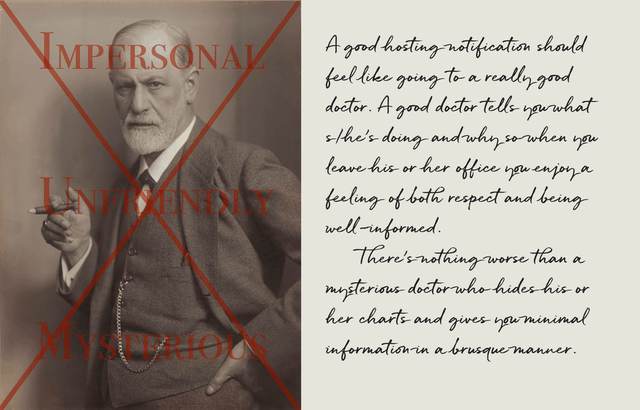Editor’s note: Service interruption notifications are the unloved sibling of newsletters and welcome emails. They just don’t get enough love—and for the most part are fairly terrible, anonymous, vague and menacing messages, often from a no-reply address. There is a better way.
While software is our main business now, we have some hosting clients for special services. Every once in a while of course there is either expected or unexpected downtime. We strive to let our clients know about these issues in advance (planned) and in real time (unplanned). We don’t try the tricky move that many hosts do of just trying to hide downtime.
Particularly bad for this trick was WiredTree (who don’t exist any more). WiredTree had tight service agreements which they didn’t want to honour. Solution: WiredTree should have relaxed their service agreements and informed customers about downtime pro-actively instead of actively trying to deny documented downtime (from our own monitors).
Hi {NAME TAG},
There will be a planned server maintenance on {DATE}. You may experience some short downtime on your website {WEBSITE TAG} during that period. Feel free to contact us for any questions you have.
Thank you for your understanding.
Making the web work for you,
Foliovision
Let’s start with the good: it will arrive with the client’s own name and even his or her website name. Awesome. At least the client will feel like an individual and not a nameless entity among thousands.
What’s wrong with this apparently polite and professional message?
- First, the note talks about “planned server maintenance”. That won’t cover emergency services very well. It’s terribly vague.
- Next, the period is covered by a whole date. I don’t know about you, but I’d much rather know about a two or three hour maintenance window than wonder about a whole day.
- Natalia asks for questions. The note is going out to avoid questions. So this is just creating a bunch of noise for everyone. The client will have to write us to find out what is going on. Awful.
- There is no precision. The note should tell the clients exactly what maintenance we are doing and why. People like to be treated like adults.
- It includes an arrogant generic message about understanding. As we haven’t share any information with the client why on god’s green earth should s/he offer us any understanding at all.
- There’s no real signature. We never sign any communications with this anonymous corporate style “Foliovision” or “Foliovision Team”. Every communication is signed by a member of our team. If Natalia is on point, she should be signing it. If I’m on point, I should be signing it. If Martin is on point, he should be signing it.
Yes the soulless lawyers at Adobe, Microsoft and Apple are trying to make it common practice to treat users like a pack of dummies who don’t deserve to know anything about what is happening to their computers or applications. But surely we don’t aspire to pollute the world further with bad practices at Foliovision?
Isn’t our goal the opposite:
- to be personable
- to be precise
- to be open
- to treat clients as adults and as friends
Hopefully yes.
A good hosting notification should feel like going to a really good doctor. A good doctor tells you what s/he’s doing and why so when you leave his or her office you enjoy a feeling of both respect and being well-informed. There’s nothing worse than a mysterious doctor who hides his or her charts and gives you minimal information in a brusque manner.
So what does a good hosting service interruption notification look like:
Hi {NAME TAG},
We are [updating PHP] on your server in the afternoon of {DATE} between 14:00 and 16:00 GMT. Your site {WEBSITE TAG} will go offline for a [few minutes] during that period. If you notice any performance or functionality issues after the update, please let us know right away.
Thanks for being part of Foliovision!
Making the web work for you, Natalia
What’s better this time?
- Personalised.
- Exact reason.
- Precise time.
- Site named.
- Downtime specified.
- Pleasant and explicit request for help isolating any post-update issues. This helps the host as it means there are extra testing eyes and makes the client feel more comfortable as they are invited to participate.
- No condescending demand for understanding. An expression of gratitude instead.
- A person on the other end. Natalia – here she is. She could consider linking to her profile from her name but that might come across as attention-getting rather than helpful.
Final crucial bonus point: reply address
Make sure you use a working reply address which is actually monitored. Do not use a no-reply address under any circumstances. Sure the beancounters will tell not allowing customers to respond to support messages will reduce support costs. It will also deeply frustrate and anger customers. Just don’t do it.
I hope this helps you write better form notifications for your own business. We can only improve technical notifications one service at a time. If you have any tips or ideas, I’d love to hear them.

Alec Kinnear
Alec has been helping businesses succeed online since 2000. Alec is an SEM expert with a background in advertising, as a former Head of Television for Grey Moscow and Senior Television Producer for Bates, Saatchi and Saatchi Russia.


Leave a Reply